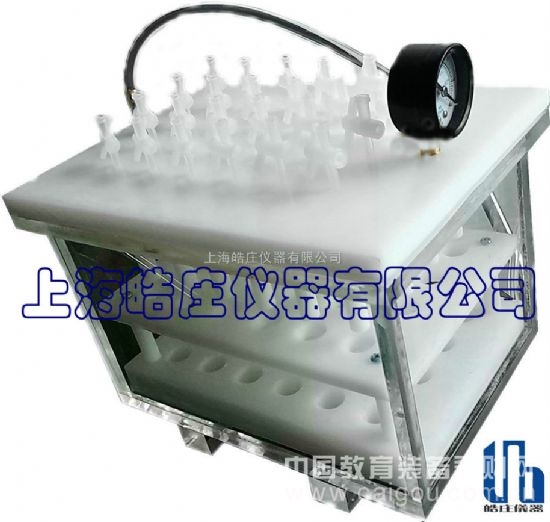Shanghai Xinzhuang Instrument Co., Ltd. develops the LNB brand solid phase extraction device, which is energy-saving and environmentally friendly and domestically leading. Professional manufacturing is more secure and affordable. Shanghai Xinzhuang Instrument Co., Ltd. is a professional manufacturer of ultra-clean workbench, providing clean and clean workbench for sterile, dust-free and clean environment for medical and health, pharmaceutical preparations, purification engineering and other fields, and more ultra-clean work. For information, please contact Shanghai Xinzhuang Instrument Co., Ltd., and look forward to your consultation!
Principle of solid phase extraction: Solid phase extraction is a physical extraction process involving both liquid and solid phases. In solid phase extraction, the solid relative separation has a greater adsorption capacity than the solvent that dissolves the separation. As the sample solution passes through the adsorbent bed, the isolate concentrates on its surface and the other sample components pass through the adsorbent bed; high purity and concentrated isolates are obtained by adsorbing the adsorbate only by adsorbing the isolate without adsorbing other sample components.
1. Retention and elution: The most common method in solid phase extraction is to install the solid adsorbent in a syringe-like column, let the sample solution pass through the adsorbent bed, and the compound in the sample either passes through the adsorbent or remains in the adsorption. On the agent (depending on the relative adsorption of the adsorbent to the solvent). "Retention" is a phenomenon of attraction between the adsorbent and the molecules of the separator, such that when the sample solution passes through the adsorbent bed, the isolate does not move on the adsorbent. Retention is the role of three factors: the separation, the solvent and the adsorbent. Therefore, the retention behavior of a given isolate varies in the presence of different solvents and adsorbents. "Elution" is the process of removing the separation of the separation agent from the adsorbent by adding a solvent that attracts the separation material more strongly than the adsorbent. 2. A brief process of solid phase extraction: one sample includes the separation and interference through the adsorbent; the adsorbent selectively retains the isolate and some interferents, and the other interferent passes through the adsorbent; the adsorbent is rinsed with a suitable solvent, The previously retained interferent is selectively rinsed off and the isolate remains on the adsorbent bed; the purified, concentrated isolate is rinsed from the adsorbent. 3. Capacity and selectivity: The capacity of the adsorbent is under optimal conditions, and the amount of unit adsorbent can retain a total amount of strongly retained isolate. The capacity of different bonded silica adsorbents varies widely. Selectivity is the ability of the adsorbent to distinguish between the isolate and other sample matrix compounds, that is, to retain the isolate to remove other sample compounds. A highly selective adsorbent is an adsorbent that retains only the isolate from the sample matrix. Adsorbent selectivity is the function of three parameters: the chemical structure of the isolate, the nature of the adsorbent, and the composition of the sample matrix.
Principle of solid phase extraction: Solid phase extraction is a physical extraction process involving both liquid and solid phases. In solid phase extraction, the solid relative separation has a greater adsorption capacity than the solvent that dissolves the separation. As the sample solution passes through the adsorbent bed, the isolate concentrates on its surface and the other sample components pass through the adsorbent bed; high purity and concentrated isolates are obtained by adsorbing the adsorbate only by adsorbing the isolate without adsorbing other sample components.
1. Retention and elution: The most common method in solid phase extraction is to install the solid adsorbent in a syringe-like column, let the sample solution pass through the adsorbent bed, and the compound in the sample either passes through the adsorbent or remains in the adsorption. On the agent (depending on the relative adsorption of the adsorbent to the solvent). "Retention" is a phenomenon of attraction between the adsorbent and the molecules of the separator, such that when the sample solution passes through the adsorbent bed, the isolate does not move on the adsorbent. Retention is the role of three factors: the separation, the solvent and the adsorbent. Therefore, the retention behavior of a given isolate varies in the presence of different solvents and adsorbents. "Elution" is the process of removing the separation of the separation agent from the adsorbent by adding a solvent that attracts the separation material more strongly than the adsorbent. 2. A brief process of solid phase extraction: one sample includes the separation and interference through the adsorbent; the adsorbent selectively retains the isolate and some interferents, and the other interferent passes through the adsorbent; the adsorbent is rinsed with a suitable solvent, The previously retained interferent is selectively rinsed off and the isolate remains on the adsorbent bed; the purified, concentrated isolate is rinsed from the adsorbent. 3. Capacity and selectivity: The capacity of the adsorbent is under optimal conditions, and the amount of unit adsorbent can retain a total amount of strongly retained isolate. The capacity of different bonded silica adsorbents varies widely. Selectivity is the ability of the adsorbent to distinguish between the isolate and other sample matrix compounds, that is, to retain the isolate to remove other sample compounds. A highly selective adsorbent is an adsorbent that retains only the isolate from the sample matrix. Adsorbent selectivity is the function of three parameters: the chemical structure of the isolate, the nature of the adsorbent, and the composition of the sample matrix.

Folding Walking Cane for Elderly
NINGBO JENNY IMPORT & EXPORT CO.,LTD , https://www.jenny-china.com